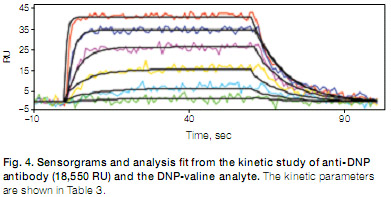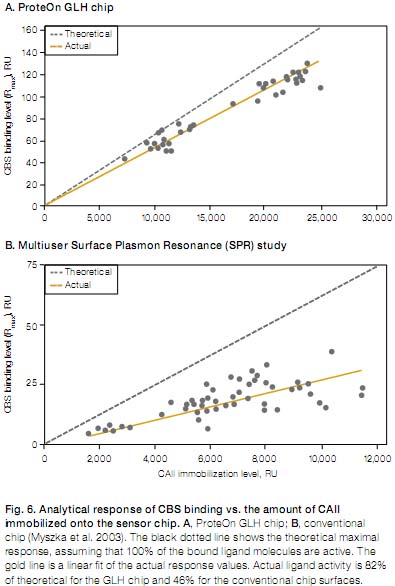Many small molecule compounds have special reactive groups that can bind to certain specific proteins or nucleic acids, stimulate or inhibit the activity of biological macromolecules, thereby affecting the life process. A wide variety of vitamins, coenzymes and other substances in the human body are these active small molecule compounds. On the pharmaceutical side, there are many small molecule compounds with special activities ranging from 200 Dalton to thousands of Daltons. Therefore, small molecule drug screening, optimization and drug mechanism research have become the focus of pharmaceutical and pharmacological research. At present, there are different methods for different purposes from the means of research in this area. However, if the interaction kinetics and affinity between certain compounds and target proteins are to be determined, the best approach is non-SPR technology.
The ProteOn XPR36 Protein Interaction Array System is a new generation of SPR biosensors launched by Bio-Rad in 2007. It has a 6×6 chip format, which can fix six kinds of proteins simultaneously or in stages on the chip, and then the compound (analyte) flows through all the ligands in parallel at six different concentrations, and the reaction curves of 36 pairs of interactions Simultaneous recording and simultaneous analysis. The kinetics and affinity constants of the interaction between a drug and multiple different target proteins can be analyzed in a single injection. This analysis method not only greatly improves the analysis speed, but also because the multiple concentrations and multiple different ligands and analytes react under the same conditions, the results are the most accurate and the repeatability is the best.
The ProteOn XPR36 system analyzes small molecule compounds using the most sensitive GLH chip. The chip has a longer matrix and more carboxyl sites, so it can bind more ligand proteins, and the protein activity remains better. Such a chip is capable of generating a high reaction signal and is very suitable for analyzing small molecule compounds. Here are a few examples of using this chip to analyze the interaction of proteins and small molecule compounds:
Interaction of CAII proteins with small molecule inhibitors:
The CAII protein was first labeled on the GLH chip. The amino acid coupling was used to dissolve the CAII protein with NaAc pH 5.0 and labeled on the chip to 21,200 RU. The small molecule inhibitor solution is applied after the baseline is stabilized. After the reaction was completed, the results were analyzed using ProteOn Manager software. The names, molecular weights, maximum concentrations and results of these small molecule inhibitors are shown in the table below. The reaction curves are shown in the figure below:
name | MW | Maximum reaction concentration ( m M ) | k a (1/Ms) | k d (1/s) | K D (M) | R max (RU) |
Sulpiride | 341 | 250 | 2.52 × 10 3 | 0.26 | 1.0 × 10 -4 | 188 |
Sulfanilamide | 172 | 50 | 2.40 × 10 4 | 0.12 | 4.8 × 10 -6 | 112 |
Furosemide | 331 | 50 | 5.15 × 10 4 | 0.04 | 7.1 × 10 -7 | 180 |
CBS | 201 | 50 | 2.83 × 10 4 | 0.03 | 1.2 × 10 -6 | 105 |
Dansylamide | 250 | 10 | 1.33 × 10 5 | 0.09 | 6.5 × 10 -7 | 105 |
1,3-benzene- disulfonamide | 236 | 10 | 1.11 × 10 5 | 0.09 | 8.1 × 10 -7 | 99 |
Benzenesulfonamide | 157 | 50 | 1.17 × 10 5 | 0.12 | 1.0 × 10 -6 | 114 |
7-fuoro-2, 1,3-benzoxadiazole- 4-sulfonamide | 217 | 2 | 4.64 × 10 5 | 0.01 | 2.8 × 10 -8 | 82 |
Acetazolamide | 222 | 2 | 9.28 × 10 5 | 0.02 | 2.6 × 10 -8 | 99 |
Methylsulfonamide | 95 | 2,500 | - | - | 3.2 × 10 -4 | twenty two |

The small molecule compounds used in the above experiments have very small molecular weights, so the signal is much lower than that of macromolecular proteins. The GLH chip effectively increases the signal of the reaction by increasing the amount of the mark, and the obtained result is consistent with the results obtained by the previous conventional chip analysis. At the same time, it should be pointed out that all these reactions were completed in one or two days, which greatly shortened the analysis time.
Interaction analysis between Anti-DNP antibody and DNP-labeled amino acid:
If the protein molecules as ligand are very large (more than 100 kD), then these molecules are used for steric hindrance at the time of labeling, which will occupy multiple binding sites of the matrix, resulting in a decrease in labeling efficiency. To this end, many people use the ratio of molecular weight of ligand to analyte to measure the sensitivity of the chip or instrument. The GLH chip can achieve 400 times detection sensitivity, which means that even if the ligand is 400 times more molecularly than the analyte molecule, the interaction can still be detected. To this end, we designed an interaction experiment between a small molecule antibody (about 150 KD) and several antigens. The specific information and reaction curves of each experiment are shown in the following table and the following figure:
name | MW | k a (1/Ms) | k d (1/s) | K D (M) | R max (RU) |
DNP-glycine | 241 | 1.99 × 10 6 | 0.095 | 4.77 × 10 -9 | 36 |
DNP-valine | 283 | 1.24 × 10 6 | 0.098 | 7.90 × 10 -8 | 41 |
DNP-tryptophan | 370 | 7.14 × 10 5 | 0.251 | 3.52 × 10 -7 | 75 |

The above examples are all for detecting small molecular compounds having a molecular weight of only two or three hundred, and the molecular weight of the antibody is large. In the experiment, the antibody was labeled with 18550 RU, so that an analyte having a molecular weight difference of such a large amount can be detected.
Determination of Labeling Activity of CAII Protein In the detection of small molecule compounds, the protein activity as a ligand has a great influence on the sensitivity of detection. Many people tend to ignore this problem when doing SPR experiments, because many experiments are not as sensitive to protein activity as SPR. In the above two experiments, if the protein activity lost more than 1/2, it is difficult to imagine how to detect such a small molecular weight compound. The problem is that amino coupling almost inevitably results in a decrease in protein activity, probably because the active site of some proteins is covered by the matrix on the chip. To this end, we have designed an experiment to calculate the viable protein signal on the GLH chip based on the Rmax values ​​of many compounds and CAII interactions. Finally, a comparison with the labeled signals visually seen during labeling can be calculated. The ratio of activity after protein labeling to total protein.
The method of this experiment is to mark the CAII protein on the GLH chip and a chip of a conventional matrix, respectively determine the Rmax value of a series of compound reactions, and then calculate the activity of the protein based on the molecular weight and binding ratio of the two molecules. The protein activity measured in each experiment was not exactly the same, and linear regression of these data gave an average value of activity. See below: 
In the above figure, we can see that the protein activity on the GLH chip is higher, reaching 85%, while the protein activity on the traditional chip is only 46%, that is, a large part of the protein loses its activity during the labeling process. The high activity of the protein on the GLH chip means that more molecules can be combined with the analyte, resulting in higher signal and higher sensitivity.
Vegetable Hollow capsule manual
Name:Hollow Vegetable Capsule
Major components:HPMC(Hypromellose) and purified water
Character:The product is cylindrical and is made of two hard and elastic empty sacs made up of two sets of cap and body. The bag is smooth, uniform in color, smooth in incision, free of deformation, non-toxic and harmless, and is no odor
HPMC: It is an anhydroglucose of the cellulose.HPMC can be derived from cotton seeds
Function: Used for containing solid drugs. Isolation of herbs
Specifications:Size0,size1,size2,size3,size4,size5
Store:Keep in a cool, dry, airtight place
Manufacturing:Zhejiang Honghui Capsule Co.,Ltd
Add:Qingshan industrial area, Xinchang County, Zhejiang Province(Chengguan Town, Quanqin)
Color Capsule,Hpmc Color Capsule,3 Hpmc Color Capsule,Size 3 Hpmc Empty Capsules
Zhejiang Honghui Capsule Co.,Ltd , https://www.hhcapsule.com